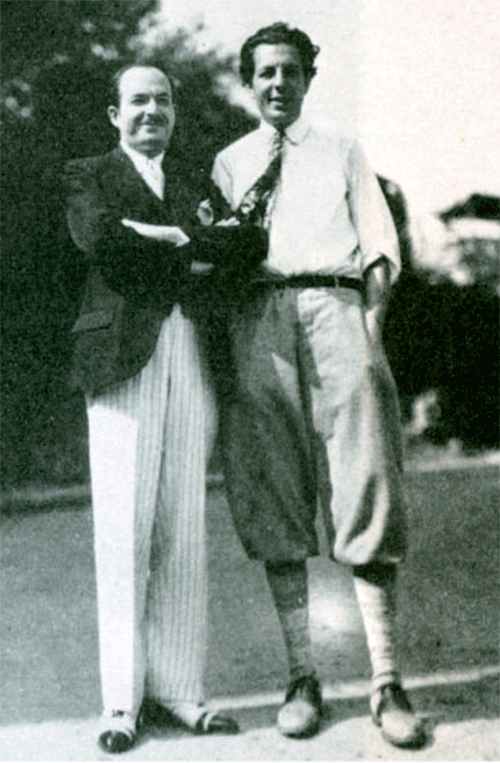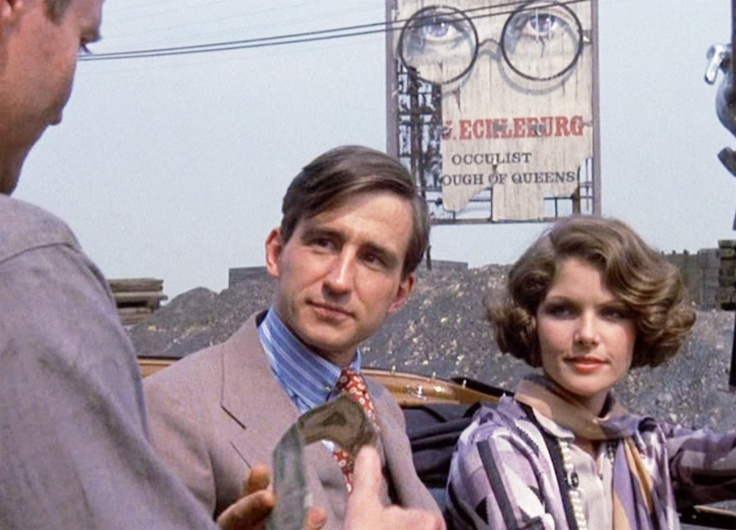
Would you ever have guessed that Charo–she of “coochie coochie” fame–has a connection to the iconic original (1925) cover of F. Scott Fitzgerald’s The Great Gatsby? The creator of the gouache painting, titled ‘Celestial Eyes’, was Francis Cugat (1896 – 1981), the brother of Charo’s husband, orchestra leader Xavier Cugat. Commissioned to do the dust cover art in 1924, while Fitzgerald was still at work writing, Cugat received $100 for his efforts.

An interesting aspect of the cover is that, rather than Cugat having been inspired by anything in Fitzgerald’s manuscript, the image is his own conception and Fitzgerald actually co-opted it for the story: “For Christ’s sake don’t give anyone that jacket you’re saving for me,” he wrote to his editor, “I’ve written it into the book.” What Fitzgerald may be referring to is a billboard that’s mentioned in the novel, an ad for an ‘oculist’ by the name of Dr. T.J. Eckleburg:

I love everything about the cover: the eyes (with their human irises) and vivid red lips suspended in a rich, blue night sky; the explosion of saturated color that looks like a carnival or boardwalk attraction (if the Vegas strip existed in the early 20’s it could have been depicted like this); the lines above the eyes that appear to suggest the creases of a cloche hat; the vertical line of light blue under the left eye (a shed tear?, an exclamation point?); the serif font.
But surpassing all of the various cover images trotted out over the years (and there’s a ton of them; see below for just a small sampling), as well as all five movie adaptations (including a silent one in 1926, just a year after the book was published), is the book itself, with its clear, unadorned prose. Like many others over the years, I read Gatsby for the first time in high school. I have a very clear memory of the day when, during a class discussion, my English teacher, Mr. Coburn, noted that the word daisy came from the Old English name dægeseage, meaning “day’s eye”, and then said that the ‘eye’ of any day is the sun…and Daisy was, truly, the sun of Gatsby’s world: she was the center of his universe, everything revolved around her. My mind was blown: that was the first time I understood that writing had layers of meaning to be mined, that there was real significance to be found if we took the time to read thoughtfully.
And the ending is, well, classic:
“Gatsby believed in the green light, the orgiastic future that year by year recedes before us. It eluded us then, but that’s no matter–tomorrow-we will run faster, stretch out our arms farther….And one fine morning—–
So we beat on, boats against the current, borne back ceaselessly into the past.”

Loved the book and cover when I first read it long ago. I didn’t recall the origin of “Daisy” being given as instruction to students in Greenville, SC, so found that quite interesting….. Have you seen all of the movie adaptations? I only recall the most recent one, very lush but empty (purposefully?), and it made me go back and read the novel again when it came out.
LikeLiked by 1 person
I’ve seen the 1974 (Robert Redford) and 2013 (Leo DiCaprio) versions and was underwhelmed by both. I need to check out the 1949 (Alan Ladd) version, and am intrigued by the 2000 version, which I’d completely forgotten about. Of interest: Gatsby is played by Maggie Smith’s son, Toby Stephens. I probably shouldn’t say this, since I haven’t seen all five versions, but I suspect that the definitive Gatsby movie is yet to be made.
LikeLike
Loved this Jeanno— and I had no idea about the Cugat connection. I always found myself wondering what Gatsby saw in Daisy. To me she seemed to be the very definition of vapid. I have only ever seen the 1974 version and Mia Farrow’s portrayal did nothing to persuade me that Daisy had an IQ higher than a pigeon. Maybe another actress could change my mind? Maybe that’s who Daisy really is? (A vapid pigeon)
Enlighten me.
LikeLiked by 2 people
LOL, couldn’t agree more Lori! I saw the ’74 version right when it came out in 1974, long before reading the book (peak of my pre-teen crush on Robert Redford). Since I was only 12, my mother had to take me. At the end, I remember her saying how shallow she thought Tom and Daisy were. At that point in my life, shallow was an adjective I understood only as it related to water. Vapid, shallow…both apt descriptors. Maybe Daisy was a completely different person when she first crossed paths with the young Jay Gatz…maybe her life with Tom, and all that money, shelled any substance out of her. (IMO, Carey Mulligan, whom I’ve enjoyed in other roles, was also a vapid pigeon in the Baz Luhrmann extravaganza).
THANK YOU for checking in! Love having your voice in the mix.
LikeLiked by 1 person
SO— it would seem that Daisy really wasn’t what poor Jay imagined her to be. So was she a projection of his hopes, dreams, ideals? A pathetic substitute for… what??? I will admit to not being all that smart when it comes to figuring out all the layers of meaning and nuance in classic novels, but this one has always eluded me.
LikeLiked by 1 person
Indeed, she was not the person he thought/hoped she was. He made himself into the kind of man he thought she would admire, but his plan backfired. Nick acknowledges right at the beginning of the book that Gatsby is pretty much the only person for whom he didn’t have scorn when everything was all said and done. (They were all vapid pigeons!!) He noted Gatsby’s “heightened sensitivity to the promises of life” (a phrase I’ve always loved) and his “romantic readiness such as I have never found in any other person and which it is not likely I shall ever find again.” And then: “Gatsby turned out all right in the end; it is what preyed on Gatsby, what foul dust floated in the wake of his dreams that temporarily closed out my interest in the abortive sorrows and short-winded elations of men.”
LikeLike
Poor Gatsby… he deserved better.
I also loved the human figure irises on the cover art. So cool, so subtle.
LikeLiked by 1 person
Sorry— meant the human figure pupils!
LikeLike
TGG has been on the ‘re-read’ list for so long now I cannot imagine joining in a conversation about the novel. So I’ll stay in the shallows and vapidly opine that my favourite cover is the blue 30s deco one. Though I’m quite attracted to the 2005 Penguin photo. What an interesting elevated perspective. Are we spying on this privileged pair?
LikeLiked by 1 person
I like that particular shot as well, Bruce…both the perspective and the sepia tint. When I searched for some other covers to highlight, I was actually dismayed at how many there were to choose from, so was happy to hit upon that image that presented several in one shot. And the book is a must re-read. After writing this post, I realized I’m due again…
LikeLiked by 1 person
Actually— now that I really look at it, I guess it is more iris than pupil. Crazy Cugat— got me all confounded and confuzzled.
LikeLiked by 1 person
Confuzzled: that is *absolutely* a coinage I’ll be using in the future….! 🙂
LikeLike
Wow; lots of feedback!
LikeLike
And now a word from your sci-fi/fantasy reading, tv-watching friend…I’ve never read TGG or seen any of the movies. But I do like the cover art and seeing all the different covers.
LikeLiked by 1 person